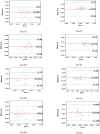Timing in Lower Limb Complex Movement Tests for DanceSport Athletes: Relation between FitLight Trainer and IMU Measurements
- PMID: 36772495
- PMCID: PMC9921716
- DOI: 10.3390/s23031456
Timing in Lower Limb Complex Movement Tests for DanceSport Athletes: Relation between FitLight Trainer and IMU Measurements
Abstract
We examine the relation between two devices used in measuring the timing in lower limb complex movement tests for DanceSport athletes, an inertial measurement unit (IMU) and a FitLight Trainer device, with the latter regarded as the gold standard method in the field. Four tests are selected to cover the lower limb movements. The research sample comprises 21 experienced dancers from different dance disciplines, performing the four tests with each of their lower limbs. Compared using concurrent validity, the two devices used show great agreement for estimating the total tests' run times, with interclass correlation coefficients between 0.967 and 0.994 for all tests. This agreement is additionally confirmed by Bland-Altman plots. As an alternative to other devices, the IMU sensor has proven to be a precise and suitable device for measuring timing and testing in sports. Its mobility, light weight, and size are advantages of this device in addition to measurement accuracy.
Keywords: FitLight; dance; inertial measurement unit; lower limb movements; sport; timing measurements; wearable devices.
Conflict of interest statement
The authors declare no conflict of interest.
Figures







References
-
- Erlikh V., Shibkova D., Baiguzhin P. Digitalization of operational diagnostics of functional reserves and assesment of athletic fitness. Human. Sport. Med. 2020;20:52–66. doi: 10.14529/hsm200107. - DOI
-
- Pustišek M., Wei Y., Sun Y., Umek A., Kos A. The role of technology for accelerated motor learning in sport. Pers. Ubiquitous Comput. 2021;25:969–978. doi: 10.1007/s00779-019-01274-5. - DOI
MeSH terms
Grants and funding
LinkOut - more resources
Full Text Sources
Research Materials
Miscellaneous

